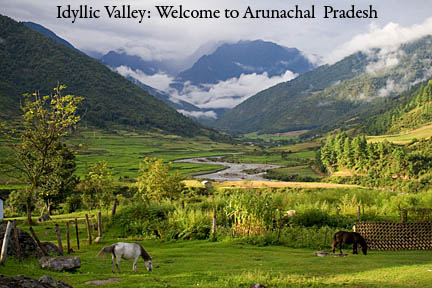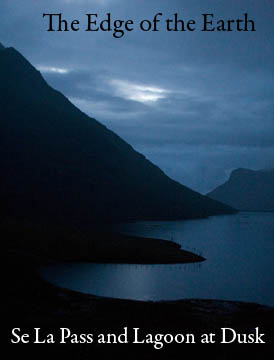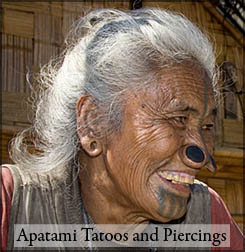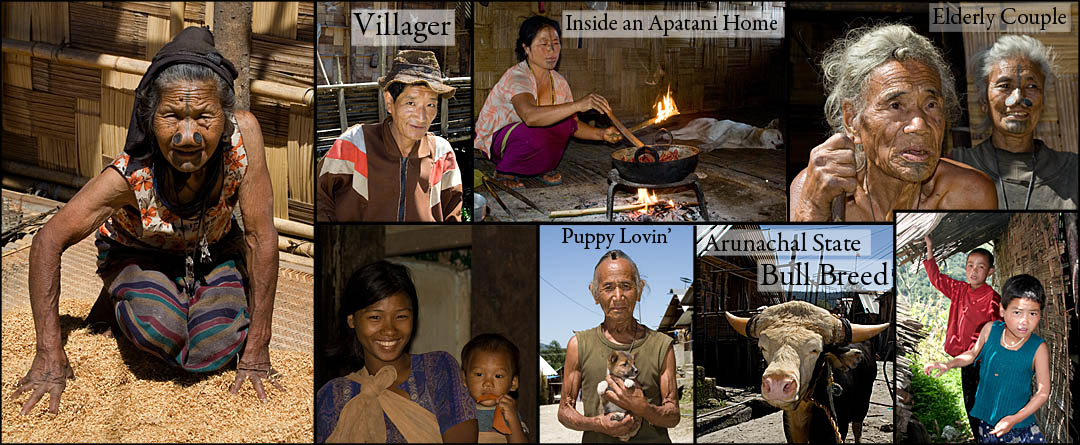

|
All Photographs © Sam Oppenheim
|
|||||||||||||
| ||||||||||||||
| |||||||||||||||||

By Sam Oppenheim "Let thy Love's sunshine kiss the peaks of my thoughts and linger in my life's valley where the harvest ripens" - Rabindranath Tagore: Crossing #53 1. "The Edge of the Earth" In Shillong I befriended Nir and Efrat, a wonderful Israeli couple on their honeymoon, who agreed to try to visit Arunachal Pradesh with me. Separately we could not have traveled there, so it was fortuitous that we, the only foreign tourists in town during the off-season, were in the same hotel and had similar travel plans. Permits for this border-region-state are strictly controlled and only available for groups of 4 or more foreigners. Despite rain, power failures, and bad phone connections, we managed to fax copies of our passports to an agent who promised to cut through some of the red tape and make permits. 
On Rosh Hashannah 2007, Two Israelis, an American, and an "invisible" British man had a permit waiting for them at the Arunachal border. 8 hours driving brought us to a road junction where we met our savior, Lawrence Koj, a kind, funny man who cut through bureaucracy and made our 4-person permit in only 48 hours. That evening we enjoyed a lovely drive along flooded rice paddy fields with clouds reflected in their waters. Suddenly, however, we turned off the road onto a rutted dirt road that disappeared straight into the woods. Our guide explained that we would sleep in a charming eco-camp canvas tent with attached bath on the Arunachal-Assam border. September 14th was a drive unlike any other. Departing at 6am we drove throughout the day and night, occasionally feeling our destination was getting farther away, rather than closer. Which it actually did, once, when we made a wrong turn! The road twisted from green lush jungly foothills to narrow curves along the side of mountains. The farther we got from flat lands, the worse the landslides, rain, and potholes became. Occasionally the paved road had washed down the hill and we attempted to maneuver the gravelly shoulder-hugging landslide-bypass. Eventually we reached the "Edge of the Earth" - a 14,000 foot (4600 Meter) mountain pass - at dusk. We were neither here nor there- where land meets sky, Heaven mingles with Earth, and day finds night. Through the rainy windshield we saw clouds of fog dancing with the mountaintops and a beautiful lagoon playing hide-and-seek, reflecting a mercurial cerulean in the stormy-weather day's fading dusky light. We did not want to drive in the rain at night, but because our travel had been slowed terribly by road conditions we had little choice. The last town before Tawang had no hotel, so we arrived in Tawang during a downpour at 11pm after 17 hours of slow mountain driving. |
|||||||

|
|||||||
|
2. "Time Capsule"
"Time swallows up everything except character; this is the only thing it cannot touch" - Paramananda Tawang is a time capsule. It is a beautiful Buddhist city, perched high in the Himalayas and enclosed by purple-black mountains on all sides. This section of India is actually claimed by China and ecologically part of Bhutan or Tibet. Home to Earth's second-largest Buddhist Monastery, it is the birthplace of the 6th Dalai Lama. This special sacred place is a very ancient, very beautiful outpost in the high Himalayas. Although it is normally very lively, we happened to arrive during a Buddhist holiday, so the monastery was somewhat deserted and very quiet except for some monks playing games. Since everyone seemed to be laying low we did the sensible thing and "kidnapped" Regina, the local kind friendly restauranteur. We hired a car for a daytrip to the lakes. Beyond the town the mountains hid more military outposts and temples which we drove past, stopping only for paperwork and prayers, mostly praying for less paperwork. Finally we cleared a ridge and spread out below us was the promised land: neon-green grass and shimmering steel-blue lakes. It was beyond lovely. We stopped at 5 of the larger lakes before feeling we had had enough, but we still didn't turn around. |
|||||||

|
|||||||
Beyond India's highest-altitude military exercise training camp the road dropped past a waterfall and led us to another spectacular site. The sun emegred burning off clouds and brightening our day figuratively and literally. Then we arrived at the famous Shungatser lake. This lake was brand new, geologically speaking, having formed in 1972 after an earthquake. What makes it so special are the eerie black skeletal trees still standing in its dark aquamarine waters. Like body casts in Pompeii they bear witness to life cut short by natural disaster, and reveal how quickly the landscape changed. I meditated on a large rock, almost unable to close my eyes because the outer peace rivaled my inner peace. I remember watching the ripples on the water which seemed cradled between steep mountains, and all of it cloaked in swiftly moving fog. Before leaving the mountains above Tawang, our driver had one more surprise for us. He took us on a gravel road to a small village with a beautiful new temple where I photographed the adorable local children. For our last day in Tawang, we awoke at 4am and attended the sunrise temple puja. I photographed the novice monk children eating breakfast, praying, and sweeping as the sun rose and illuminated them from the windows behind us. Their luminous red robes in the solar spotlight made the already spiritual children look like angels. |
|||||||

|
|||||||
In an attempt to find traditional Buddhist Monpa tribal people Regina showed us around an older part of town. After I had given up, we came across a house she said looked promising. Knocking and calling out to a man sitting on his porch, we decided he was deaf and let ourselves in. After he saw us he positively beamed. Standing up on spindly old legs, he nearly toppled over while graciously inviting us into his house. He took us on a tour. Soot-Blackened kitchen walls were hung with shiny-clean silver pots and tools, and something was simmering in a pot on coals. Then he took us in a room where he put on his ornamental dagger, picked up his rifle, and even wore a pair of horse-bells. He was a little senile, but beautifully proud of his heritage. Whereas his home felt intimately lived in, the white-walled room of his daughter felt sterile even though it looked like any teenager's room, replete with photos and pink frilly decorations. He sadly explained that their only child was married in another town never came back. His nearly blind wife stayed outside, and when we left I was sad for their loneliness. The yard had leather tanning tools and other things strewn about which reminded me of lessons in anthropology and archaeology about traditional lifestyles. And here they are living and dying out. Here lies a beautiful, stunning piece of a lost world, slowly disappearing, hidden behind a fence in the middle of nowhere in the Himalayas. |
|||||||

|
|||||||

3. "Bamboo and Button-noses" "If you look for ugliness, you will find it everywhere. When you look for beauty you will find that everywhere" - Narayana The next week was full of traveling. Down to Assam, then back up into Arunachal Pradesh along a different mountain river valley. In Ziro we visited the famous Apatani tribals and then drove back down again. The villages were amazing. This whole region of the Himalayas is like a trip back in time if you ignore the satellite dishes and mobile phones. Their houses are made entirely of bamboo: Large bamboo stilts support the strong frame, which is clothed in woven split-bamboo walls. These tribals are famous for their facial piercings and tattoos that guidebooks say were instituted so the women would look ugly and not be taken by rival tribes in raids. Since 1970, however, no woman has undergone the tattooing or piercing, so as the population ages another piece of cultural diversity fades away. The highlight of the trip was being invited inside a house for tea. We watched a woman cook and our guide translated as we asked the host about his life. The people here are very special and very different from central India. I can now see why separatist rebels operate in the Northeast, but, I hope for peace. At least this state (Arunachal) seems to be better off for being a part of India, as otherwise it might be taken over by China or ruled like Burma/Myanmar. |
|||||||

|
|||||||
Leaving Arunachal on Yom Kippur I found the best part of the drive were the gorgeous vistas into the lush streams and jungle valleys at some spectacular roadside bends. At one point we even spotted a swinging bridge and got out to walk across its rotting wooden floorboards like Indiana Jones. Nir, Efrat, and I then passed through Gawahati and returned to Sikkim. Again I was shadowed by rain every step of the way and still couldn't see Kachenzonga. Nir & Efrat still loved Sikkim, and I agree it is a clean, green, peaceful Buddhist gem of the Northeast, and 3 full days travel easier to reach than, say, Tawang. As September ended, we said sad goodbyes and flew to separate beach resorts - Nir & Efrat to Goa and myself to the Andaman Islands. These islands are geologically connected to a mountain range in Burma and are nearer to Indonesia and Thailand than India's mainland. They are fairly distant from everywhere, and equivalent to Hawaii in that they are ancient bio-dversity hotspots used for vacation tourism. |
|||||||

|
|||||||
4. "Lost Island Paradise" "Early in the day it was whispered that we should sail in a boat, only thou and I, and never a soul in the world would know of this pilgrimage to no country and to no end. In that shoreless ocean, at thy silently listening smile my songs would swell in melodies, free as waves, free from all bondage of words." -Rabindranath Tagore, Gitanjali #42 |
|||||||

|
|||||||
Flying in, one appreciates the beauty of these islands as lands untouched by man's hands - true wild desert islands with mangrove swamps and jungles, surrounded by beaches, rocks and reef, turquoise aquamarine shallows, and the deep ocean. There is a dreaminess to the whole vision as it unfolds through the airplane window. My Accommodation near the beach on Havelock Island was in a metal-roofed thatch hut. This is both cozy and quaint. Each morning I awakened at sunrise to the crow of roosters. My days alternated between Corona commercials, hiding from the rain while reading, and scuba diving. One particularly memorable moment was when I waded out 1/4 mile to a submerged rock and sat drinking a cold beer with the exceedingly shallow ocean waters still only halfway up my chest. Paradise. |
|||||||

|
|||||||
Sunrises and sunsets were dazzling. The shallow waters made for less swimming and more walking. Locals hunted for crabs while I hunted for the perfect photograph. During my first sunset on the island I also found fascinating the mangrove trees that were elevated off the seafloor by sturdy roots. The next morning I walked to a neighboring joint and boarded the boat for a dive. The rain did not bother us as the flourishing colorful sea life enticed us to stay longer. When the afternoons are clear I ride my rickety rusted rented bike. There ought to be a boy-scout badge for doing this on unpaved roads for 6 kilometers while wearing flip-flops. Once I went all the way to the Southern end of the island to explore, chase chickens, and chat with villagers. At dusk on my last night I rode to the Western Edge, where a sunset-facing beach splayed before me. I felt like a rebel-adventurer as I raced back home, the sunset behind me as winds rushed in with the nightfall. My iPod blasted rock music while my headlamp helped me avoid bats, bullfrogs, potholes, and night crabs. It was a glorious moment, riding in the darkness just blessed to be alive and in motion. "On the seashore of endless worlds children meet. The infinite sky is motionless overhead ad the restless water is boisterous. On the seashore of endless worlds the children meet with shouts and dances They build their houses with sand and they play with empty shells. With withered leaves they weave their boats and smilingly float them on the vast deep. Children have their play on the seashore of worlds They know not how to swim, they know not how to cast nets. Pearl fishers dive for pearls, merchants sail their ships, while children gather pebbles and scatter them again. They seek not for hidden treasures, they know not how to cast nets. " -Rabindranath Tagore, Gitanjali #60 |